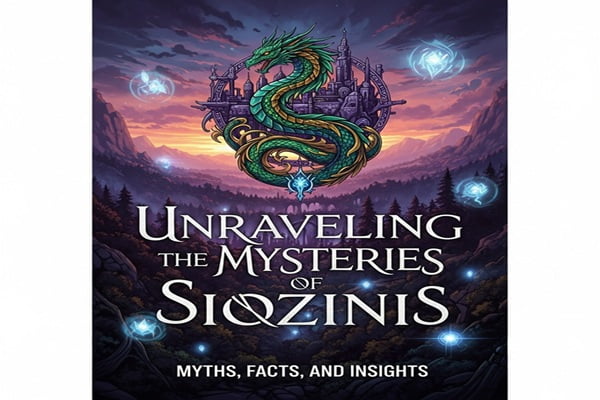If you’ve ever stumbled across the word Siozinis and thought, what on earth is that?—you’re not alone. This mysterious practice has been gaining attention among people looking for deeper meaning, mindfulness, and personal transformation. It’s intriguing, it’s ancient, and it has plenty of modern-day relevance.
But here’s the catch—Siozinis often comes wrapped in myths and mystery. Some see it as a spiritual practice, while others think it’s just another wellness trend. The truth? It’s so much more.
In this guide, we’ll explore everything you need to know about Siozinis—its fascinating history, common misconceptions, research-backed benefits, and practical ways you can bring it into your everyday life. Whether you’re completely new or a longtime practitioner, you’ll find insights here to deepen your journey.
What Exactly Is Siozinis?
At its core, Siozinis is about balance and harmony. Think of it as both a practice and a philosophy that blends movement, mindfulness, and connection. While its exact definition varies depending on cultural context, the main goal is simple: to align body, mind, and spirit in a way that promotes clarity, strength, and resilience.
It’s not about religion or rigid rituals. Instead, Siozinis is flexible—you can adapt it to your own lifestyle and goals, whether you’re seeking stress relief, physical benefits, or a deeper sense of purpose.
The Fascinating History of Siozinis
To understand why Siozinis resonates with so many people today, we need to look back.
-
Ancient Roots: Siozinis originated in small, spiritual communities, where elders passed down the practice through generations. It was seen as a bridge between humans and nature.
-
Evolving Traditions: Over time, techniques expanded. It wasn’t just about ritual anymore—it became a way of life centered on awareness and connection.
-
Modern Revival: In recent decades, researchers and wellness seekers have rediscovered Siozinis, blending ancient wisdom with modern science.
The result? A timeless practice that speaks to both tradition and today’s fast-paced world.
Common Myths About Siozinis
Like many practices with ancient roots, Siozinis is surrounded by misconceptions. Let’s clear the air:
-
Myth 1: It’s only for spiritual people.
Not true—anyone can practice Siozinis, regardless of faith or beliefs. -
Myth 2: You need years of training.
Nope. You can start small and see benefits right away. -
Myth 3: It takes hours every day.
Even a few minutes of practice can make a difference. -
Myth 4: It’s just another wellness fad.
Actually, research is showing real benefits for mental health, emotional resilience, and even physical well-being.
By busting these myths, more people can approach Siozinis with curiosity rather than hesitation.
What Science Says About Siozinis
You might be wondering—does science actually back this up? The answer is: yes, increasingly so.
-
Stress Reduction: Studies suggest Siozinis helps regulate stress responses, leading to calmer moods and better resilience.
-
Brain Benefits: Neuroimaging shows activity in areas linked to mindfulness and relaxation.
-
Sleep & Anxiety: Regular practice has been tied to improved sleep quality and reduced anxiety symptoms.
-
Emotional Balance: People who practice report feeling more grounded and less reactive to daily challenges.
While more research is needed, the evidence so far highlights why Siozinis has stuck around for centuries.
5 Key Benefits of Practicing Siozinis
So, why should you consider trying it? Here are some standout benefits:
-
Improved Flexibility and Strength – Gentle yet effective movements engage muscles and promote physical balance.
-
Mental Clarity – Focused attention helps cut through brain fog and boost productivity.
-
Emotional Resilience – Siozinis supports calmness during stressful situations.
-
Community Connections – Group practice fosters meaningful social bonds.
-
Self-Awareness – It encourages you to pause, reflect, and connect with your inner self.
How to Bring Siozinis Into Your Daily Life
Getting started doesn’t have to be complicated. Here are practical tips:
-
Start Small: Dedicate 5–10 minutes each morning for a quick session.
-
Create a Sacred Space: Choose a quiet corner in your home with calming lighting.
-
Practice Mindfulness Anywhere: Apply Siozinis principles while walking, cooking, or commuting.
-
Join a Group: Look for local classes or online communities for motivation.
-
Track Your Progress: Keep a journal of your thoughts, feelings, and breakthroughs.
The key is consistency—not perfection.
Also Read : Exploring Sinpcity: A Guide to the Ultimate Urban Escape
Real Stories From Siozinis Practitioners
One of the most inspiring parts of Siozinis is hearing how it impacts real people:
-
A young professional shared how it helped her manage work stress, saying she now feels “less frantic and more focused.”
-
A mother uses Siozinis with her children, noticing improved patience and communication in her household.
-
Long-time practitioners often describe it as a lifestyle shift—a practice that naturally flows into how they eat, work, and connect with others.
These personal stories show that Siozinis isn’t just a technique—it’s a tool for transformation.
Is Siozinis Right for You?
If you’re looking for a practice that’s flexible, calming, and rooted in both tradition and science, Siozinis could be worth exploring. It’s not about quick fixes—it’s about steady growth and long-term balance.
And the best part? You don’t need fancy equipment, expensive memberships, or hours of free time. You just need an open mind and a willingness to try.
Final Thoughts
Siozinis is more than just a wellness buzzword. It’s a centuries-old practice that continues to evolve, blending history, culture, science, and personal growth.
By separating myths from facts, recognizing its benefits, and trying out simple daily practices, you can begin your own journey with Siozinis. Whether your goal is stress relief, emotional balance, or self-discovery, this practice offers tools to support you every step of the way.
So, are you ready to give Siozinis a try? It might just be the missing piece in your path toward balance and harmony.
